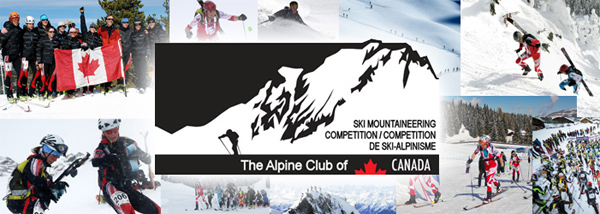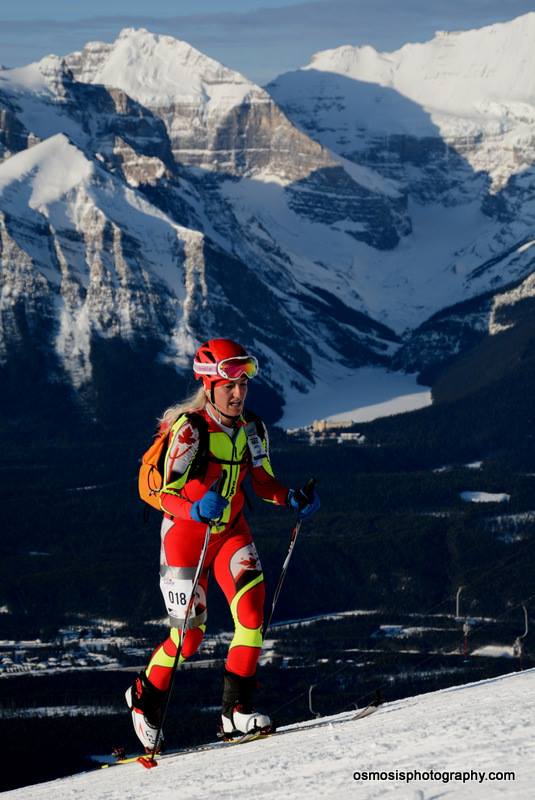
With the conclusion of skimo racing in Western Canada last weekend in Lake Louise, our governing body Ski Mountaineering Competition Canada (SMCC) has released the final rankings for this season. We will take a look at how the rankings are compiled and what it means.
Rankings and How they work
Canadian Cup Rankings:
This season’s Canadian Cup consisted of the six races (at five venues) that were sanctioned by the SMCC – those that conform with the International Ski Mountaineering Federation (ISMF) and SMCC rules. For the first time ever, one of these races was a sprint event. No vertical races were held this year and so the other five were individual events.

Top 3 Men:
- Eric Carter (USA) – 380 pts
- Travis Brown (CAN) – 330 pts
- Peter Knight (CAN) – 280 pts
Top 3 Women:
- Kylee Ohler (CAN) – 360 pts
- Michelle Katchur-Roberts (CAN) – 320 pts
- Melanie Bernier (CAN) – 300 pts
» Canada Cup Overall Rankings (PDF)
Canadian National Rankings:
The Canadian National Rankings are made up of a so called “Points List” that is designed to accurately rank athletes in comparison one to another using any possible race results for the purposes of aiding (not finalizing) in national team selection for next season.
The Points List results were compiled from all Canadian Cup races, US nationally sanctioned races (e.g. US Nationals or Powder Keg Continental Championships), and World Cup or ISMF events.
The points system was derived from that used by the Canadian Nordic Ski Team. Athletes are assigned points that represent the percentage of time they finished behind the leader. Points are handicapped by the ranking of the race winner – this means athletes who finish near the front of a highly competitive field will be rewarded with better points than finishing near the front of a weak field. For example, finishing within 20% of the winner (say Kilian Jornet) at a World Cup would be worth more points than finishing within 20% of the winner at a Canadian Cup race. The average of an athletes top three points is taken to be their overall ranking. If the athlete has only one or two races, a slight penalty is applied to their average (see notes in the below PDF sheet).
Top 3 Canadian Men:
- Nick Elson – 0.8803
- Rob Krar – 0.8383
- Peter Knight – 0.8080
Top 3 Canadian Women:
- Melanie Bernier – 0.8847
- Kylee Ohler – 0.8601
- Michelle Katchur-Roberts – 0.7828
» Canada National Points List Final (PDF)
What does it mean?
Canadian Cup:
The Canadian Cup does not seek to identify the absolute fastest Canadian skier, but rather any skier with the best and most consistent results within the Cup races. A good example of this is seen in the women’s ranking with Melanie Bernier winning every race she entered (3) but finishing ranked third because of her missing a fourth result. Had she raced one more and finished at least 3rd, she would have won the Cup.
The Vert180 appears to be a good place to get points. Only 2 of the top 8 attended. Similarly, Fernie and Nelson were less well attended than Castle or Lake Louise. It is interesting that Castle was so well attended as it is far away from almost everyone (but it’s closer for the Montana athletes). This suggests that the double race weekend – holding the sprint and individual race – is very attractive to many. Absolute ideal would be to see a minimum of two events at every race weekend in the Canadian Cup. Holding a vertical or a sprint, along an individual, does not add too much extra work for the organizers while greatly increasing attractiveness for racers from further away to attend.
Special mention should go to the very few athletes who attended every Canadian Cup race – by our count, this is only Michelle Katchur-Roberts, Travis Brown, and Peter Knight (forgive us if we missed anyone).
National Points List:
The current points list can be skewed in the event of a race like what happened at Nelson. With new snow and no set tracks, a large group of racers skied together, finishing much closer to the leader than shown in other races, thus, gaining more points than if there were well established skin tracks. This underlines the need for properly set courses and forerunners in the case of new snow. In our experience, as race organizers and athletes, we believe that a forerunner should be a must. Setting out about 1.5-2h before a race starts it gives this person plenty of time to refresh the tracks set day before and to repair any course markings that perhaps got buried or blown away overnight.
However, the points list provides valid information to the SMCC for national team selection purposes. A good example of this is Rob Krar (an accomplished ultra-runner) who is presumably hoping to race for Canada at the 2017 World Championships. With only one race in Canada (though a strong 2nd among Canadians at Nationals last week), his US results support his ranking of second fastest Canadian.


Nick Elson says
Hey Scott, no worries. I just wanted to acknowledge that it would have been preferable to make the basis for the rankings clear at the beginning of the season and that hopefully things will be more transparent going forward. Anyhow, nice racing out there this season.
Scott says
Thanks, Nick. Sorry if my question came across as a criticism; that wasn’t my intent. I appreciate the work you’ve put into the rankings system.
Nick Elson says
Hi Scott,
Apologies for any confusion with respect to the Vert 180.
I took over the rankings this year from Niall who had been doing a great job with it for many years. I had some ideas about how to make the rankings a bit more honest (consider for example that Melanie Bernier was ranked the #5 women in Canada last season) while balancing considerations such as encouraging participation in Canadian races. Unfortunately, it took me a bit of time, research, and trial and error to come up with the above system and I failed to have it all figured out and made public prior to the start of the season.
I included the Vert 180 in the Canada Cup Standings because it’s one of only a few races on the Canada Cup and because one of the motivations behind keeping track of the standings was to encourage participation in Canadian races. I also heard from a few athletes who felt it merited inclusion. I included it in the points list because I was able to calculate percentages behind the winners based on average lap time. It could be argued that the race is so non-technical that it’s not a real skimo race (I’ve never actually done it so can’t comment) but with so few races I think it makes sense to consider them all.
As I’m sure you’ve noticed, ski mountaineering racing is still somewhat in its infancy in Canada. I think that we’re getting to the point where it’s important that things like the ranking system be clear, fair, and public and I’ll try to do a better job of this going forward. I hope that this will be the case with the organization of the sport generally, but I also think it’s important to keep in mind that everyone involved is volunteering their time and that it’s still a pretty fringe sport.
Scott says
I was told before the season started that the Vert 180 was a participation event with no point value. I guess that has changed?
Matt says
OK, thanks for the explanation Nick. That sounds like an incredible amount of work for you but I do like the new system.
Nick Elson says
Hi Matt,
A person’s points at a given time were calculated based on their 3 best races over the past 365 days. So races from the previous season were taken into account in determining the points of the highest ranked athlete, especially at earlier races.
The points are intended to represent a percentage back from the best in the world. Thankfully many North Americans race against the best in the world and also amongst each other which makes a ranking like this somewhat feasible. However, it would be more accurate and representative if people travelled more widely and raced more often. This is why athletes from the East Coast haven’t been included in ranking. I simply couldn’t find enough instances where people from the East have raced elsewhere or people from elsewhere have raced out East to make any kind of fair ranking. Hopefully this will change in the future though.
In the case of American races, the points of the top athletes were calculated the same way as Canadian races (although those American athletes don’t show up on the ranking) and the points of any Canadian athletes were calculated based on their percentage behind those athletes.
Given that there just aren’t that many races and that conditions and other factors can often have a large effect on results, I don’t think there’s any perfectly objective way to compare athletes. While the Canada Cup overall rewards people who attend more Canadian races, the idea was with the points list was to compare across all races and not penalize people who seek out competitive races elsewhere. However, I would stress that the points list was just intended to be a useful tool and is certainly not the final word. My hope is that list will provide a bit of motivation to train hard and will also come to include more names in the coming years.
Stano says
Matt, I will ask someone from SMCC to answer this for you as I wasn’t involved in creating this most recent ranking system.
In my opinion, at the first race of the season, the last season’s ranking serves as point of reference in determining the handicap. From that race on the new season’s rankings determine this. However, I am also confused on couple of things, especially, objectively cross-referencing results when lets say an athlete would race twice in Canada and twice in US – what does determine which race series is higher quality?
Matt says
Awesome guys, thanks. One question – in the National scheme, when points are handicapped by the ranking of the race winner, how is the ranking of the winning athlete determined? I am thinking it would be based on their seasons results, but I can’t get to the end of this train of thought without it seeming like a circular reference…